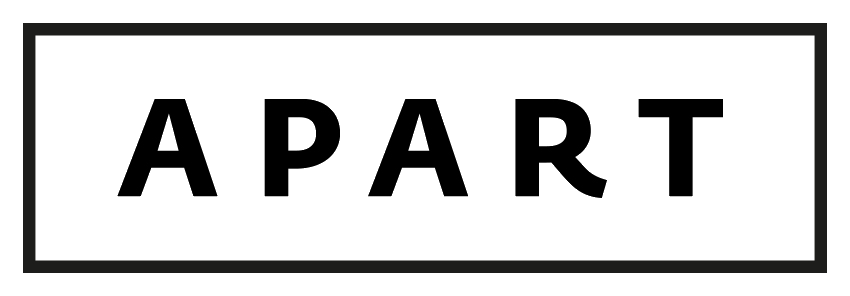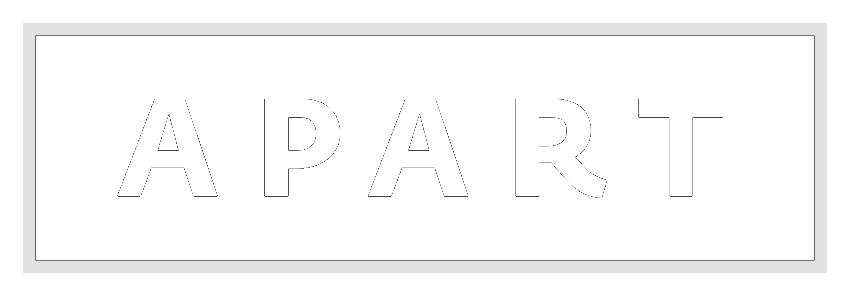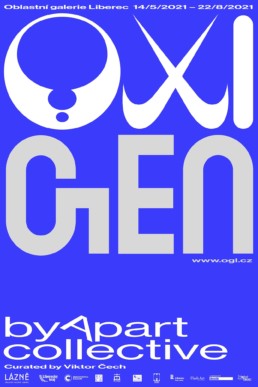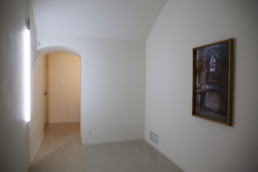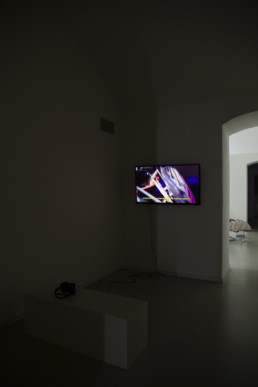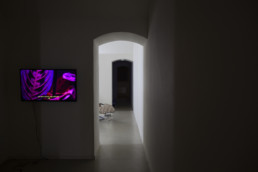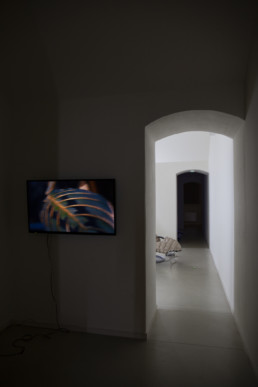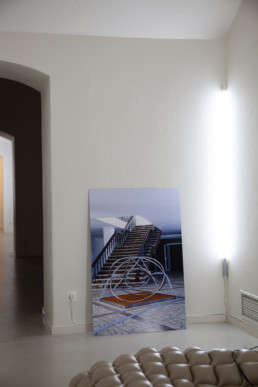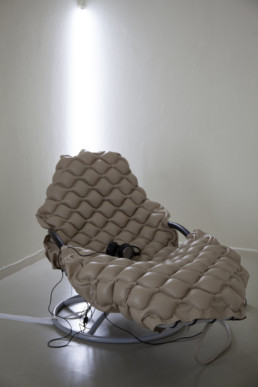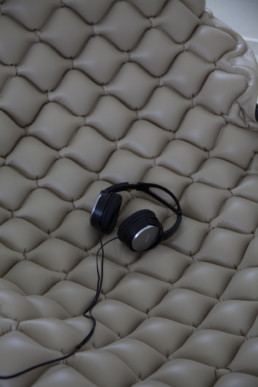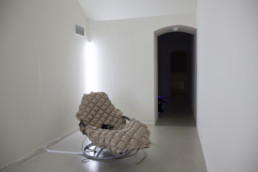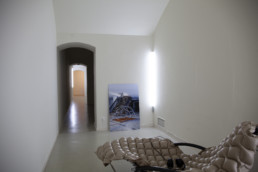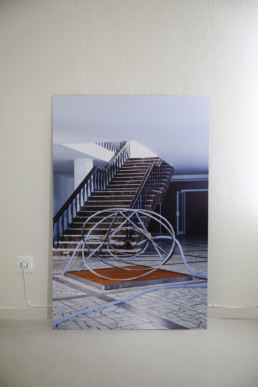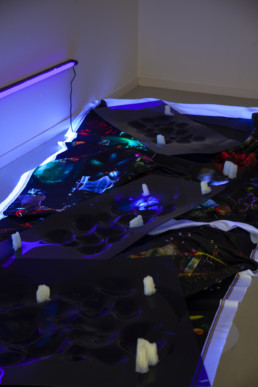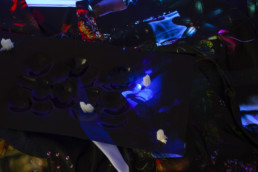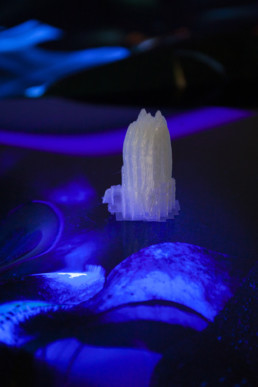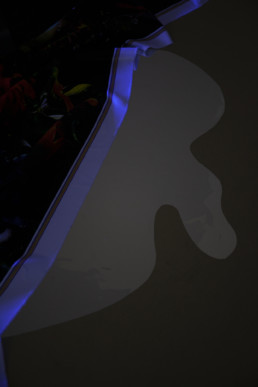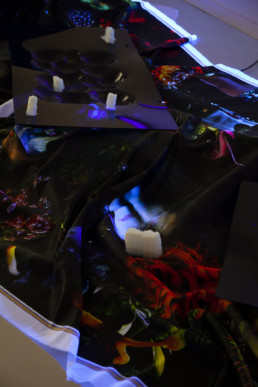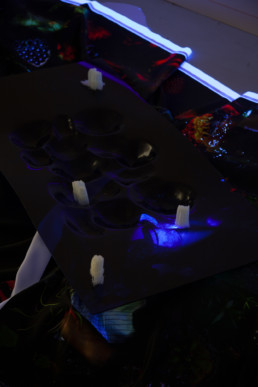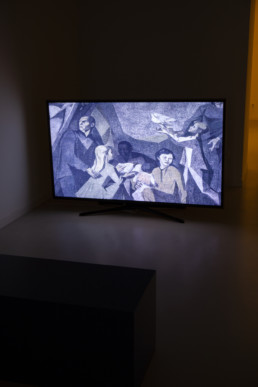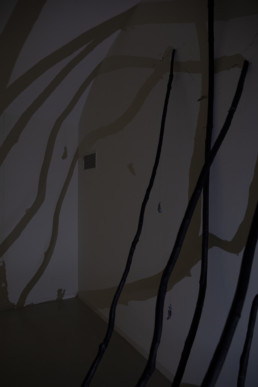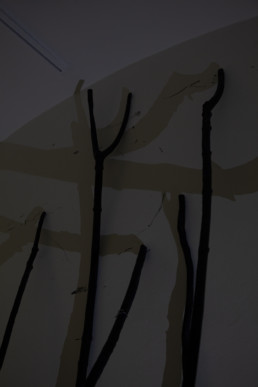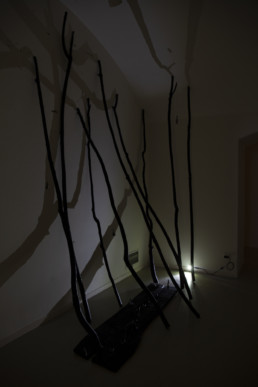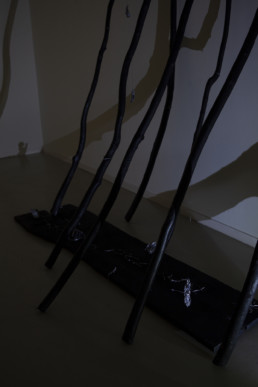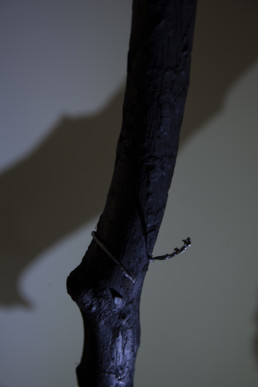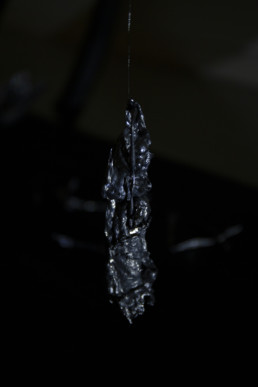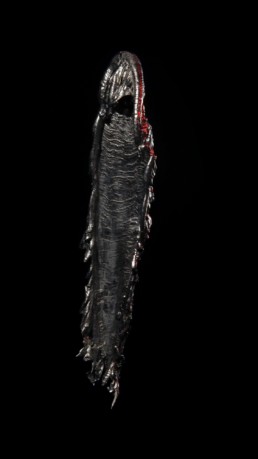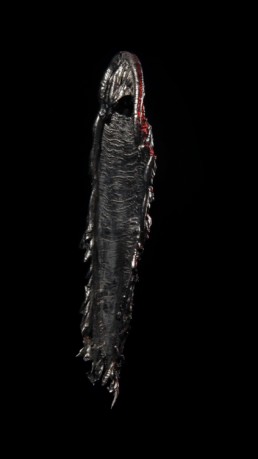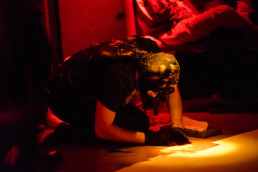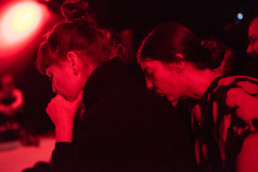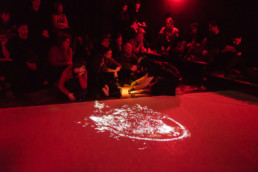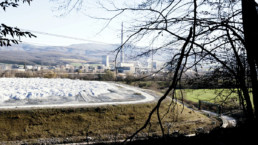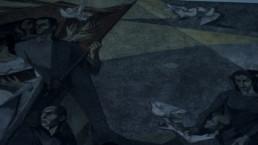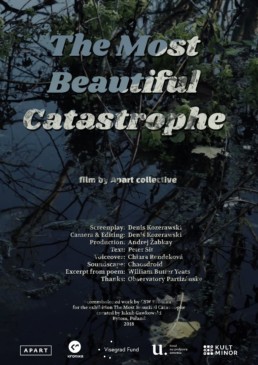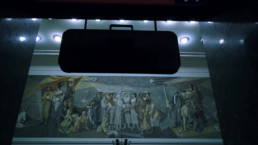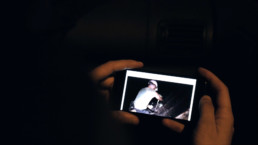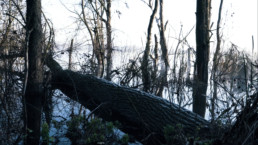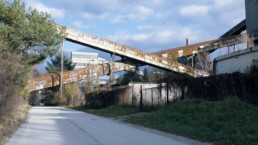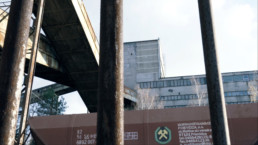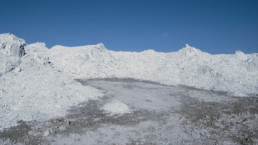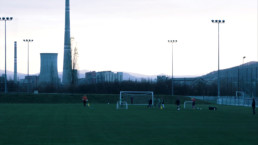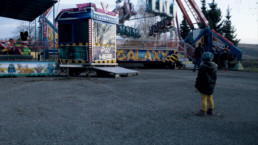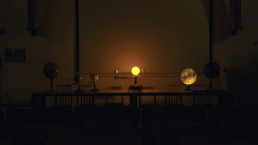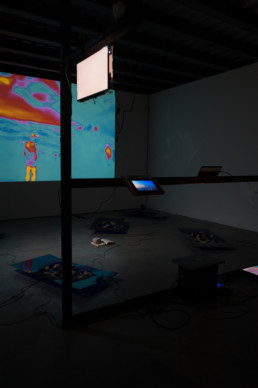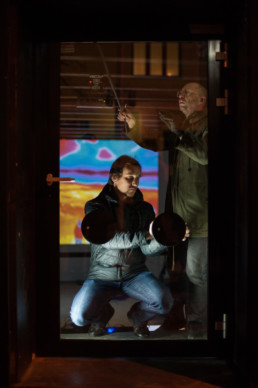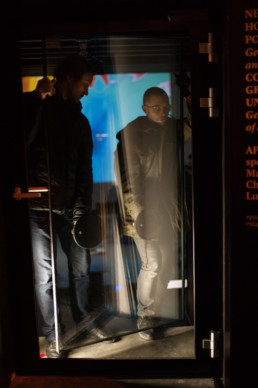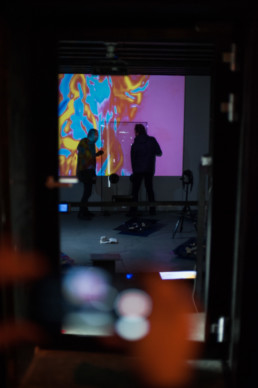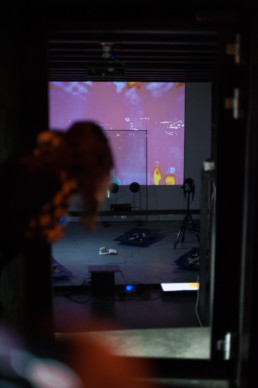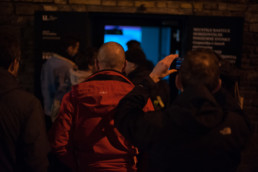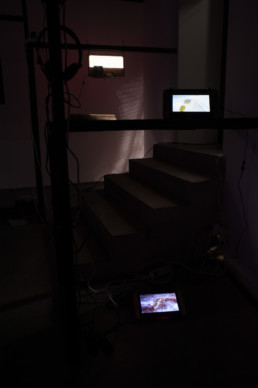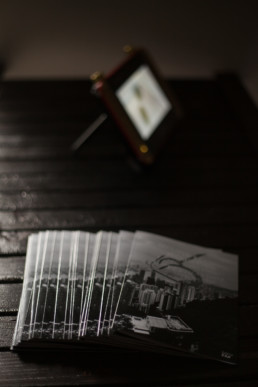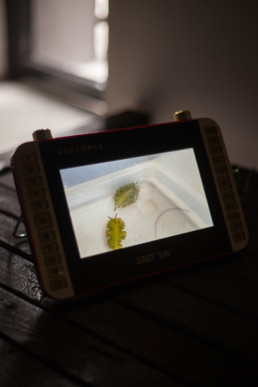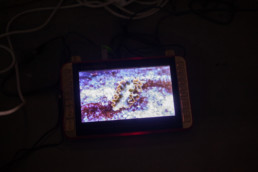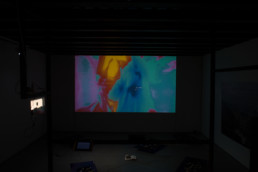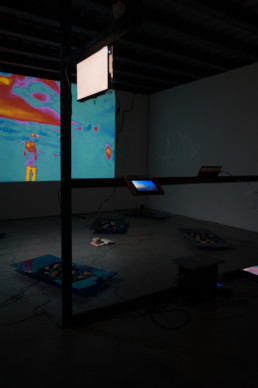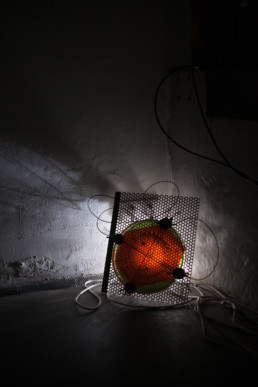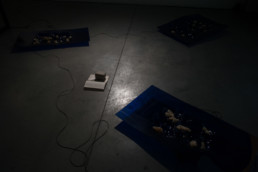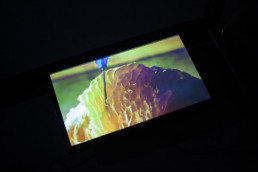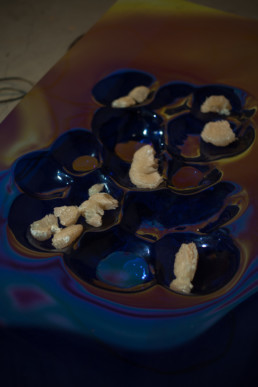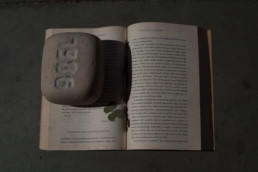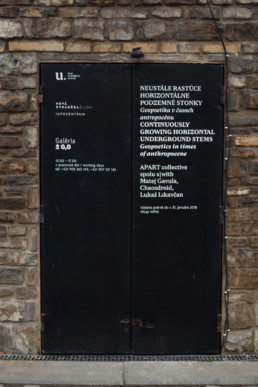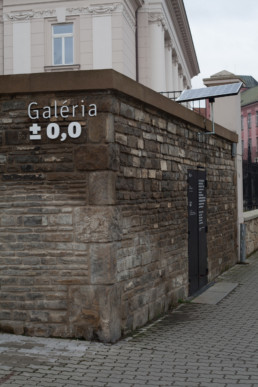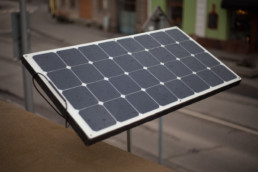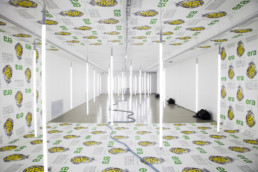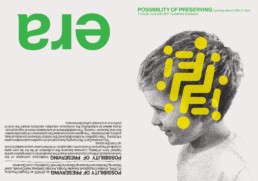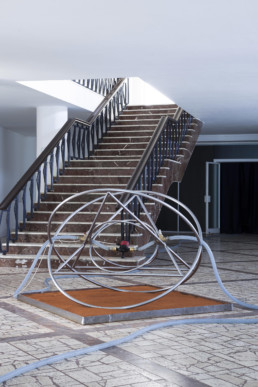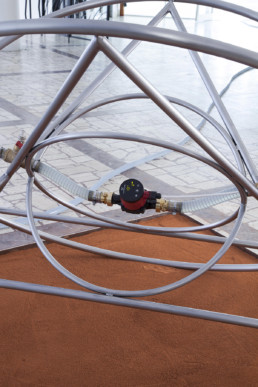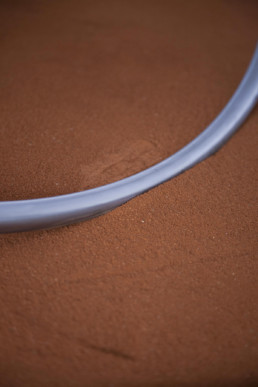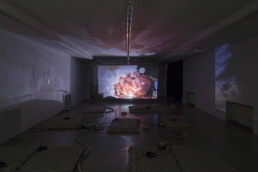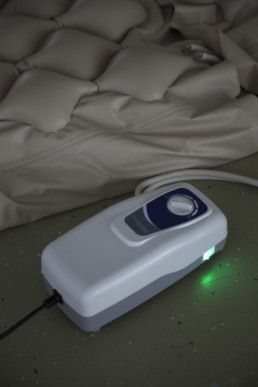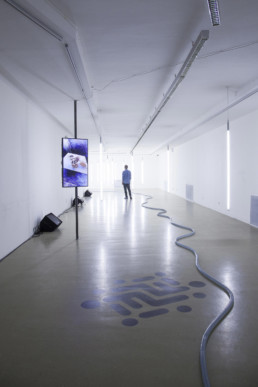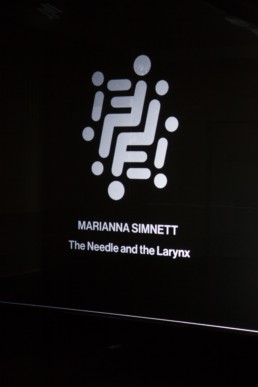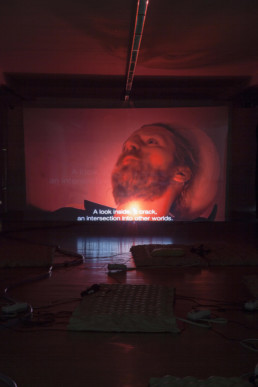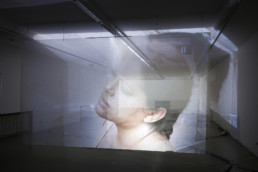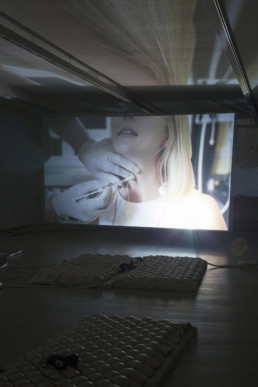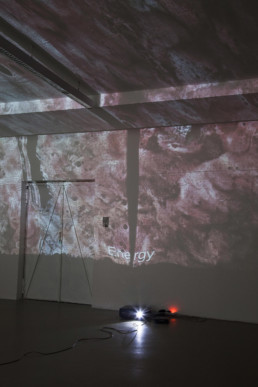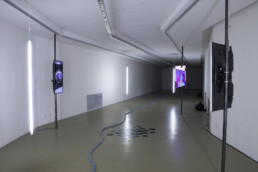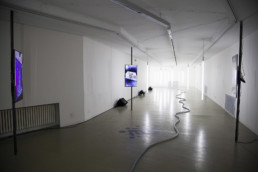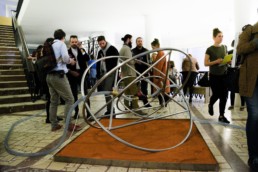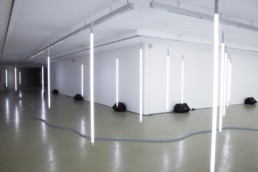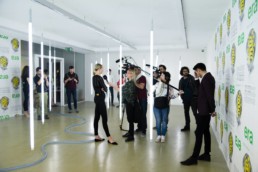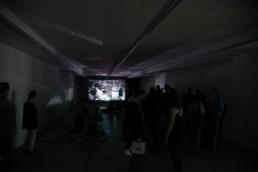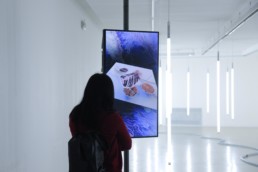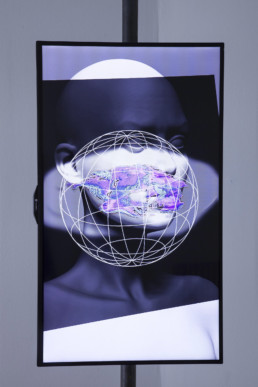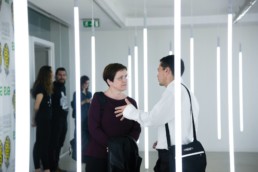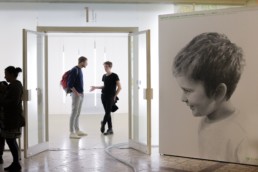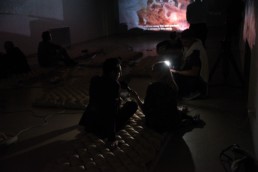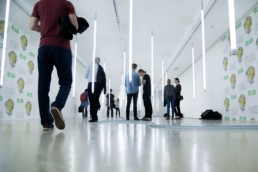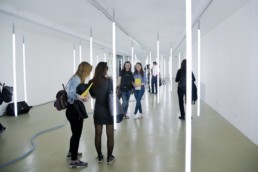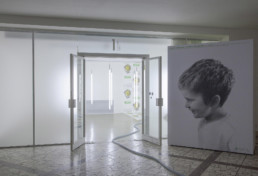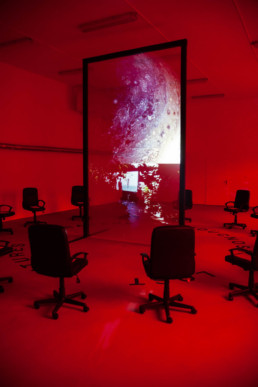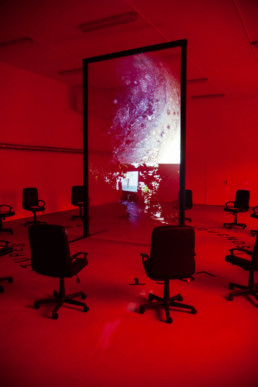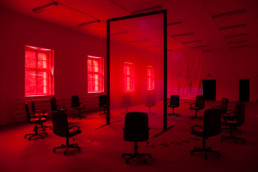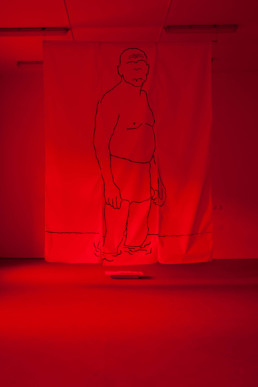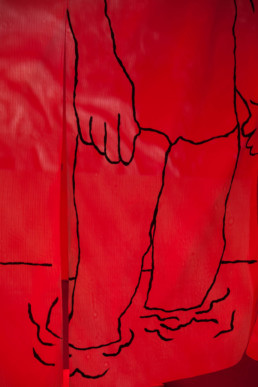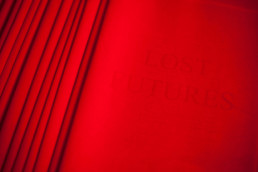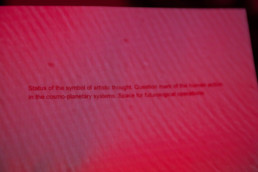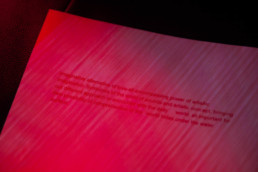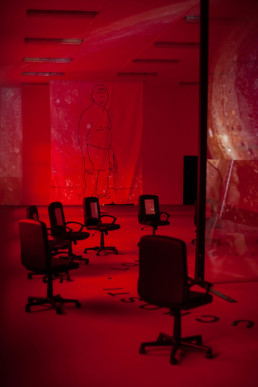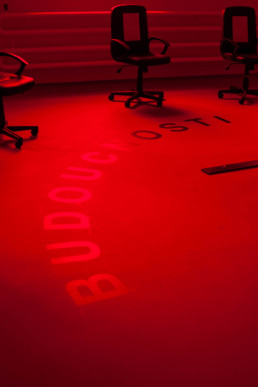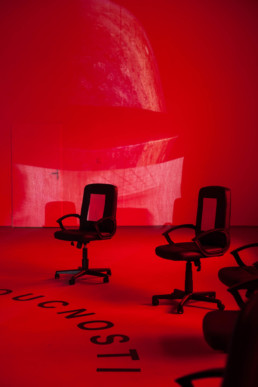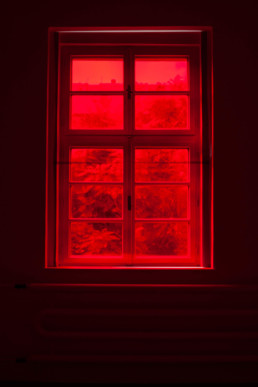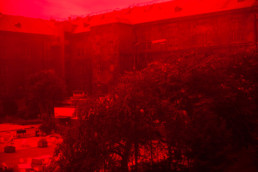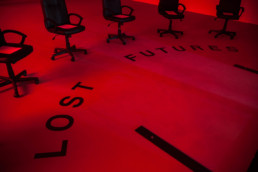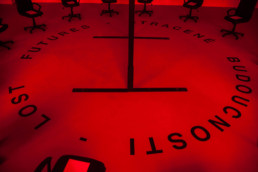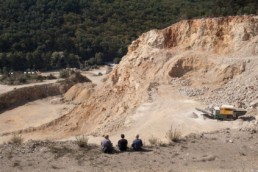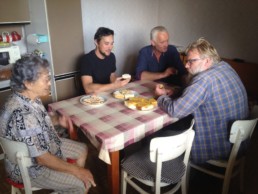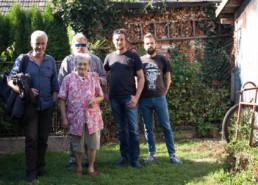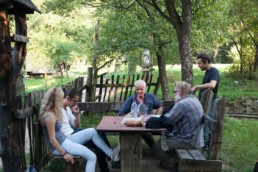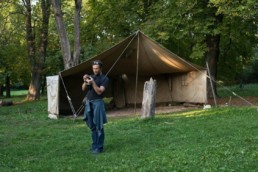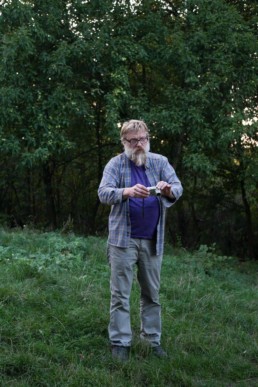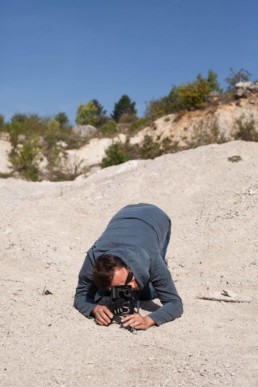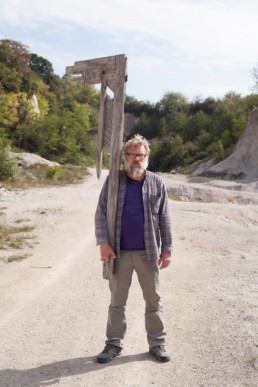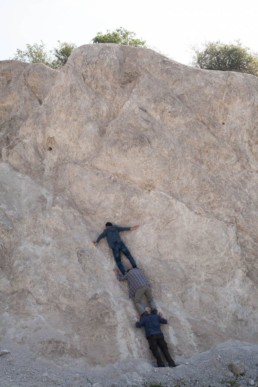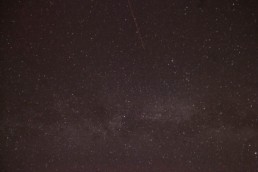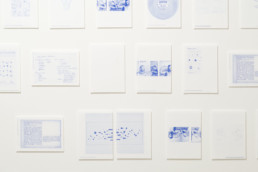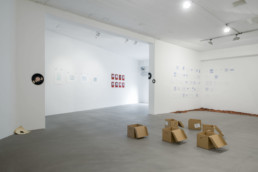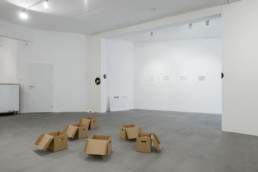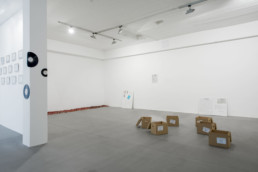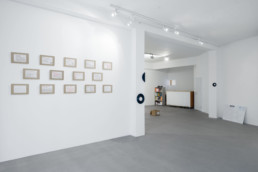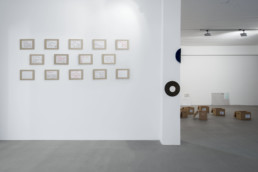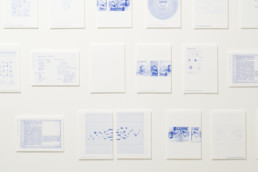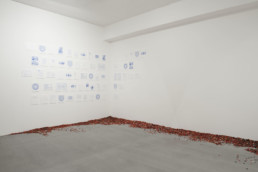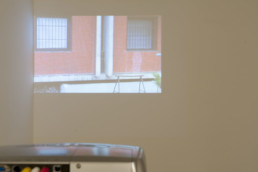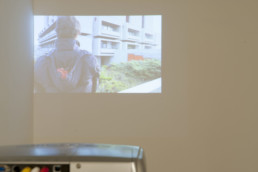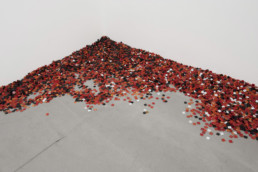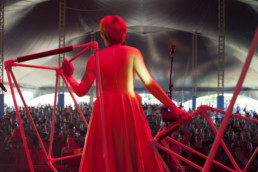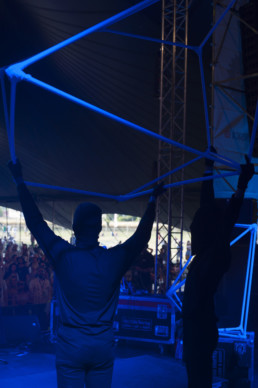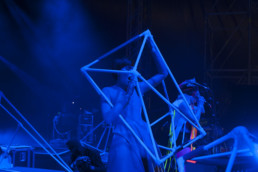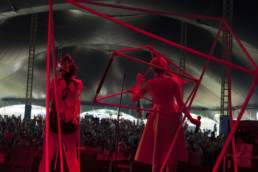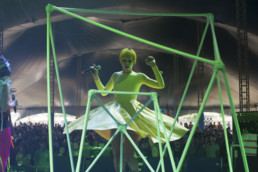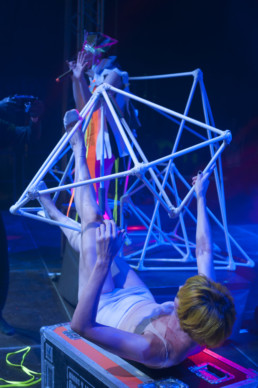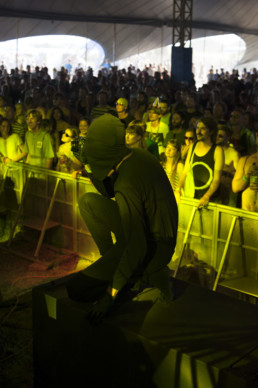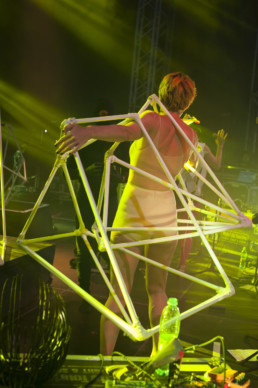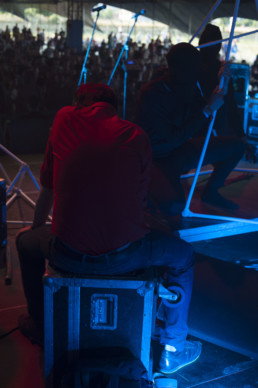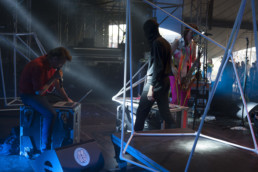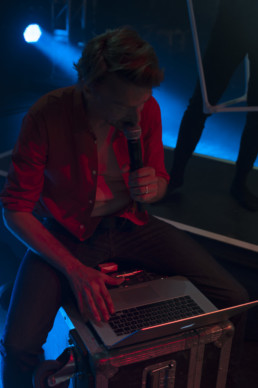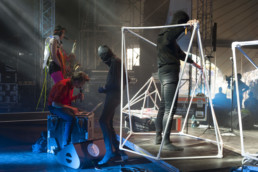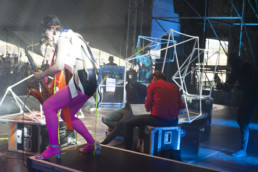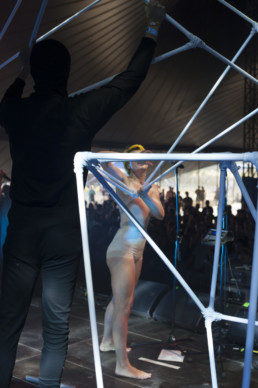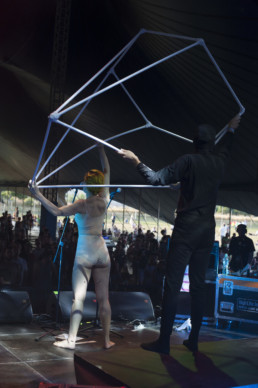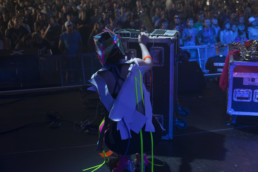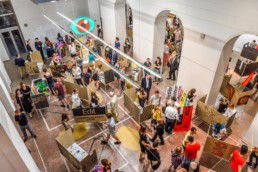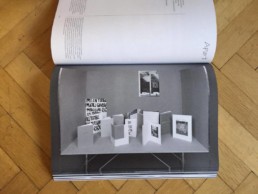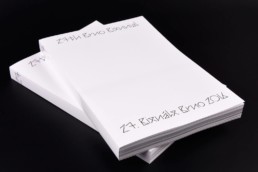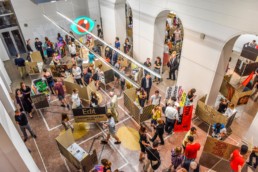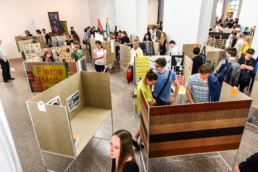OXIGEN
https://www.ogl.cz/apart-collective-collective-body
OXYGEN / APART Collective – Denis Kozerawski, Peter Sit, Andrej Žabkay / 14. 5. – 22. 8. 2021 / Oblastní galerie Liberec, Galerie 1PP / Curator and text author: Viktor Čech / Poster: Matej Vojtuš
Kyslík je látka, bez níž se stejně jako většina organismů na této planetě neobejdeme. Prostředí, v němž se můžeme pohybovat a žít své životy je neodvratně definováno její přítomností. I když jsme formováni i touhami po naplnění a zdůvodnění naší samotné existence, nakonec vždy mají slovo ony elementární biochemické reakce. Prostředí výstav současného umění je většinou stále místem, kde se při své orientaci spoléháme na symbolickou řeč vizuálních prvků a specifické vytknutí umělci zde definované reality z okolní všednosti. V mnoha smyslech těchto slov se pohyb takovou situací stává hrou i politikou, kde se diváci a tvůrci setkávají na šachovnici, v níž se ale jednoznačnost figurek ztrácí v širokém spektru jejich barev i ambivalenci jejich sémantiky. Prostředí uměleckých instalací, v nichž je divák konfrontován s kombinací výstupů oslovující jeho různorodé smysly, počínaje obrazem, slovem či zvukem a konče vůněmi či pachy, jsou příznačným důsledkem takovéhoto směřování. Umělecké realizace se zde stávají jakýmisi biopolitickými laboratořemi, v nichž je sdělení syntézou ideologických diskurzů, řeči znaků a naší biologií determinovanými senzorickými reflexy. Tato estetika laboratoře, v níž je častým zkoumaným jevem i pacientem naše lidská společnost a jí generované sociální i enviromentální problémy, tak vlastně staví diváka do role, ve které je jak pozorujícím faktorem, tak samotným laboratorním vzorkem. Jak nás naučila i kvantová fyzika, je vlastně tato obojetná pozice neodvratná. Příběh, který nám umělci chtějí vyprávět, je současně čtenou knihou i kyslíkem, v tu chvíli se v nás měnícím v oxid uhličitý.
Slovenský umělecký kolektiv APART ve svých projektech překračuje hranice mezi uměleckou tvorbou, kurátorskou, publikační a teoretickou činností i řadou dalších institucionálních aktivit. Uskupení tvořené proměňujícím se okruhem členů a členek získalo v posledních letech výraznou pozici nejen v rámci slovenské, ale i středoevropské umělecké scény obecně. Mezi témata zajímající toto uskupení patří především ta, která můžeme čekat od tvůrců vědomých si akutních problémů naší současné civilizace i jejích možných budoucností.
Na své výstavě nazvané Oxigen v Oblastní galerii Liberec APART zve diváky na cestu instalací, tvořenou řadou několika tematicky zaměřených částí. Otázky jako je klimatická krize spojená s globálním oteplováním, realita kapitalismu v postsocialistickém prostředí i čím dál víc akcelerující symbióza našich životů a biologie se světem technologií a umělé inteligence, se pro autory staly východisky pro realizace zapojující nejen vizuální prvky, ale oslovující také další smysly. Vedle intelektuálního dialogu se tak diváci setkají i se zvukovým prostředím a dalšími senzuálními podněty. Výstava vznikla jako tvůrčím způsobem pojatá retrospektiva, prezentující v rámci nového celku práce APARTU z posledních několika let. Ty jsou zde sestaveny do narativně chápané cesty výstavní instalací, přes níž nám autoři nabízejí v současnosti se zrcadlící možné budoucnosti naší civilizace.
Foto: APART Collective / Peter Sit
Tl;dr: Apart
The performative lecture is a result of our collaboration with Chaosdroid and Eva Priečková and based on the text of art theorist, T. J. Demos: The Bureau of Fire: Burning Aesthetics, whose reading forms its central part. The performance was created as a part of the Tl;dr: cycle.
Choreography handles body temperature, its shaking and its swinging in the moment of contact. The stage and sound components of the performance work with the motif of fire, burning, their layering and symbolism as central elements underlining the significance of Demos’ text. In the text, Demos points to the alarming development and consequences of the climate crisis, which articulates through the element of the all-consuming fire against the background of media and virtual spread images of catastrophic fires. He also defines the position taken by the contractor of such images and subsequently of the viewer, emphasizing his distance from the setting for disaster and the impossibility of the image representations to convey the urgency of the situation.
The performance points out that the seemingly “distant” catastrophic fires are in fact not distant, progressing at dizzying speed and destroying everything alive. It appeals to our perverse obsession with Internet-mediated images of a burning planet and puts us right at the heart of the action.
Concept & Visuals: Andrej Žabkay
Sound: Chaosdroid
Choreography: Eva Priečková
Post-production: Denis Kozerawski
Author of essay: T.J. Demos
Text translation & editing: Lukáš Makovický, Ema Hesterová
Voiceover: APART collective
Tl; dr is a literary program of the Batyskaf Project focused on creating audiovisual installations. Batyskaf invites artists from different areas to collaborate, with an emphasis on sound and visual aspects. In this way, Batyskaf aims to promote an artistic fusion that will leave the viewer with the most complex experience possible.
The Most Beautiful Catastrophe
APART collective made a visit to the region of upper Nitra to film a short movie The Most Beautiful Catastrophe, concerning coal mining and its impact on the living environment. It is our contribution, on how we try to approach ever so more growing threat of the climate change, which became a crucial topic for us to examine by artistic and activistic means. The film ties to the last year’s exhibition Continuously Growing Underground Stems: Geopoetics in time of Anthropocene, where we worked in close cooperation with Lukáš Likavčan to elaborate the topic of technological progress and its impact on global warming and on the contrary, the question of geopoetical writing with the planet, not about the planet.
What Chernobyl means for nuclear energy, climate changes means for technologies driven by fossil fuels. The way we approach our future can therefore leave nothing to chance – we must plan, think, recalculate and contextualize our existence within the planetary ecosystem. That is why we need radical political and technological imagination which pulls down the ideas of what the limits and possibilities of individual human bodies are.
We chose Kosovsko-Laskár wetlands as a key motive, located in the Central-Western Slovakia, rare and probably the only example of emerging wetlands and marshes in Slovakia. They form as a by-product of the underground extraction of coal near the Nitra river. These wetlands have been created for over 40 years of coal mining done under the surface. The landscape has been changed, large sinkholes have been created, affecting the housing. This landscape change has pushed people away from the area, forming biotopes as a way for the nature to even out with the radical intervention to the ecosystem. After several years it was abused again by a crisis situation in the still operating mine, which drained the water from its flooded bowels to the surface. The miners began to pump it straight into the creek, their skin was burned. Water mixture of ash and hydraulic emulsion managed to kill all life in that creek and all of its ichthyofauna.
Things got into movement, when just a week and a half after our visit of the mines and coal power plant in Nováky, group of twelve Greenpeace activists climbed on the top of the mining rig and hanged their transparent – asking for the end of the coal age . After the expected contact with the police they were sent to the toughest prison in Ilava to wait for further hearing under the restriction of their freedom. We consider the fact that the the seizure of the mines takes authorities such long time to execute and securing the local miner population a decent life after the closure an absolute nonsense. The planned closure of the mines in Slovakia and as well in other countries is planned in 2030, which is undoubtedly late with the prognosis of the world climate changes.
The theoretician Benjamin H. Bratton even challenges the humankind to engage with prudence in the practice of committed geodesign to avert the impending ecological disaster. In other words – we need more daring geopoetics and less stupid geoengineering.
Commissioned work by CSW Kronika for the exhibition The Most Beautiful Catastrophe curated by Jakub Gawkowski Bytom, Poland 2018
film by APART Collective
screenplay: Denis Kozerawski
camera and editing: Denis Kozerawski
production: Andrej Žabkay
text: Peter Sit
voiceover: Chiara Rendeková
soundscape: Chaosdroid
excerpt from poem: William Butler Yeats
thanks: Observatory Partizánske
WATCH FULL MOVIE
Continuously growing horizontal underground stems: Geopoetics in times of anthropocene
Anthropocene is the new geological epoch of our planet. As hinted at by its ancient Greek root of anthropos (άνθρωπος), it is the age of humans. Today, humans hold the position of the main powers shaping the Earth. According to some authors, the beginning of this era dates back to the end of the 18th century when Watt’s invention of the steam engine opened the gates of the industrial revolution and fossil fuels became the drivers of early capitalism. The aroma of burnt oil products has since then become our daily companion. Other scientists place the turning point between the Anthropocene and the preceding epoch of Holocene (which started at the close of the most recent glacial period) in the 20th century. Sometimes they even cite a very concrete date – namely July 16th 1945, when the first atomic bomb was detonated as part of tests carried out in New Mexico. The invisible, thin layer of radioactive substances which enveloped the planet after the explosion, has been forever imprinted in the future layers of the Earth’s core, which will be studied one day by geologists of the distant future in their core samples.
As it tends to happen with technology, new inventions generate new accidents. What Chernobyl means for nuclear energy, climate changes means for technologies driven by fossil fuels. The way we approach our future can therefore leave nothing to chance – we must plan, think, recalculate and contextualize our existence within the planetary ecosystem. That is why we need radical political and technological imagination which pulls down the ideas of what the limits and possibilities of individual human bodies are. The theoretician Benjamin H. Bratton even challenges the humankind to engage with prudence in the practice of committed geodesign to avert the impending ecological disaster. In other words – we need more daring geopoetics and less stupid geoengineering. This calls for sensible interfaces set up for the frequencies of interspecies diplomacy, which may include the use of the Sun as the supreme source of energy for human and extra-human activities, from the level of individual cells through our bodies to large collectives of heterogeneous agents.
The Anthropocene is a daunting epoch, anticipated and ushered in by the horrors of modernization. Modernization took many shapes and forms and we intentionally opt for a very non-Western variant – namely the modernization that China went through under Mao Zedong. By the gesture of including one of his poems in our exhibition we want to show that the brutal modernity and the no less brutal Anthropocene share the strangely delusional sense for the planet combined with a total negation of its autonomy – the Earth does not belong to us, yet we pretend that it is in fact ours.
With our exhibition, we want to escape from this paradox by means of patient construction of a new planetary perspective which does not differentiate between nature and society, the wild and the city, or people and plants – on the contrary, our perspective draws its energy from the radical idea of equality of all things; including people.
Thus, we ask: How to write the planet? That is to say: Not to straightforwardly follow its lines or fold its pages, but to genuinely co-write the planet?
Text: Lukáš Likavčan
Translation: Michal Spáda
Photo: Jan Trnka
Sound: Chaosdroid
Graphic design: APART
Documentation: Peter Sit, Andrej Žabkay
Video: Denis Kozerawski
Appeared on artalk.cz / plusminusnula.sk
Possibility of Preserving
Possibility of Preserving by APART with Parallel Practice, PLURAL, Kristína Országhová, Karaoke Tundra, András Cséfalvay, Aleš Čermák, Josef Dabernig, Nicoline van Harskamp, Marianna Simnett, Lucia Gavulová
Kunsthalle Bratislava
Opening: 30/3. 2017 6pm
Through: 25/6 2017.
The “Possibility of Preserving / Možnosť uchovávania” project is a creative work of the APART artistic group that brings together young visual artists Denis Kozerawski, Peter Sit, and Andrej Žabkay. The work of the group is not limited to author’s production only, but also includes the organization of activities related to the advancement of the discourse on contemporary visual arts (editorial, curator’s, and exhibition activities as well as cultural activism). Each aspect of the way the group functions is also reflected in the way it approaches the creation of the exhibition. The core lies in interconnecting various perspectives and settings, including also other invited authors from the field of visual arts, based on the method of trial and error. Here, the primary importance is put on the process itself, while the final output remains unpredictable and, in principle, secondary. The authors enter a dialogue, exploring the fragile boundaries of artistic production – (non)production by way of subverting and questioning the approved procedures. Pursuing the collective approach to the project, they, by definition, challenge the work of art in its final form – as an ultimate artifact. Similarly, they test the exhibition format through their directorial, regulative, and stage-managerial inputs. The viewer thus encounters and becomes part of the emerged situations, legitimizing them through his or her very presence.
The alchemistic symbol of transformation is a principal element of the entrance object of the exhibition – a pump propelling water circulation through the whole exhibition area in the shape of a gallery. The circulation is secured through the supply of solar energy, generated by way of a solar panel that has been installed by the authors on the roof of the House of Art building. Its physical placement in the space navigates the viewer to move around the exhibition area, dominated by the light gradient of transition from absolute glare to darkness enabling one to perceive film screenings in the end of the exhibition area. Towards the end of the exhibition the viewer is encouraged to change his or her vertical position to a horizontal one when invited to lie down, to free him or herself from the context of the exhibition/institution/surrounding environment and to perceive without interruptions the flow of consecutive screenings related to the theme of the exhibition. The omnipresent vocal accompaniment introduces the visitor to a vision of the future era, characterized by the full automation of human labor. Thus, it outlines a possible state of affairs in the “hereafter“, metaphorically embodied by Pangea Proxima as the ultimate form of an ancient-new arrangement of the continents. The authors interconnect various notions, while drawing from the ideas of Russian cosmism and manifold contemporary speculations about transhumanism and the evolution of humankind in the future.
They use a database of texts to choose passages that – in their new arrangement – create a meta-text responding to the authors’ visions of a human gathering based on ADA, a collective artificial intelligence. The latter has transformed society for human’s sake and enabled an ideal state of society where work is not required as a necessity, generated by the capitalistic system. Rather, work is transformed into the principle of creative thinking/ art production. Art has become the ultimate social capital. It has become everything; the definitive phase is emerging when art permeates everyday life. ADA describes the newly-emerged society and how it must have defined itself over against the presently existing social problems. The authors call the new establishment ERA (Earth Recharging Association). This is meant not in the sense of a corporation. Rather, it is envisaged as a society that may represent a business entity, but also (and especially) a human gathering – a system of collective human existence and interaction.
The exhibition is a utopian and futurological story that draws from the contemporary discourse on the issues of minorities, gender questions as well as the issues such as corporeality, mortality, social establishment, identification, culture, and overall world order. However, it offers neither answers nor solutions. Instead, it asks questions and admits failures. The key moment represents the conditions that predetermine human transformation and emancipation into a higher form of being, with the machine becoming equal to the human as the former begins to feel for itself. The environment of the exhibition is supposed to evoke the ideal state of affairs, when a being is introduced into and becomes an inseparable part of a total artistic installation. The being is encouraged to pursue a frame of mind when no energy output is required; to become one with the environment and to resign oneself to the care of technology.
The ideas and points of departure of the exhibition are integrated in the image of a child that symbolizes the exhibition’s visual identity. It represents a straight-forward answer to the question of what the world will look like at the moment that work ceases to exist. Is preservation possible? Everyone (not only parents) would like that…
Lucia Gavulová
A part of Monolith
20. 9. – 22. 10. 2017
opening 20. 9. 18:00
open wed-sun 2-8:30 PM
Socialist feminism
Antifašistički front žena
Jewish Labour Bund
Panfilia
Cosmohumanism
Družina
Biocosmists
Trotskyism
Anarcho-demokraták
Gaudiopolis
Solidarność
Anarcho-collectivism
Davisti
Levy Front Iskusstv
Strandzha
We are constant participants of a conference call. Voices are constantly speaking to us, seeking our attention. But who leads this call? Who speaks and what does he tell us? Who has the voice in today’s monolithic society and whose voice was denied? Who must take it violently to be heard? Who listens and who lets others to be heard? Who do we choose to listen to?
http://www.futuraproject.cz/en/karlin-studios/event/270-apart-collective-a-part-of-monolith
Museum #1
12 – 13. Sep 2015
Museum #1
micro residency
artists: Miroslav Csölle, Matej Gavula, Peter Sit, Milan Tittel, Martin Vongrej
Sitič’s Grandmum Residency began in september 2015, by micro residency of artists Miroslav Csolle, Matej Gavula, Peter Sit, Milan Tittel, Martin Vongrej. They prepared a project, ready for this space called Museum. In 2016, Erik Janeček, Denis Kozerawski and Andrej Žabkay will arrive, they participate on the Museum project as well. From 2017 we are preparing international residencies with the duration of 3 weeks, repeating one or two times a year.
Panphilia
Milan Adamčiak – Panphilia
curated by Daniel Grúň
guests: Matej Gavula, APART
opening 28 October 6 – 8 pm
duration until 16 December 2016
ZAHORIAN & VAN ESPEN Bratislava
Panphilia by Milan Adamčiak (1946) is a site of interaction, contact, and conjunction sounding of the relation between author and imaginary co-authors – interprets, in which visual imagination of music becomes real. Panphilia consists of various unrealized projects that exist only in form of manuals and instructions, as following: concerts for fictive orchestra, fictive music publisher and legal documents with fictive author’s heraldry. The word Panphilia actually comes from Greek language and means a state of loving or accepting all things. Panphilia in its genealogy activated by Milan Adamčiak has its root in Dada and Pataphysics. Because its source is everyday life, it becomes an alternative to any established institutions of art and it brings to light a different experience with this world. Panphilia has something very spontaneous and imminent in itself, it is a gift.
Milan Adamčiak is one of the first Czechoslovak artists who began systematic research into intermedia overlaps. It was principally creatively that his research was conducted, in the field of experimental poetry, action art and the so-called new music. In the second half of the 1960s he created cycles of diverse kinds of typographic grids, in which the graphic and semantic realisation overlapped with an acoustic rhythmisation of the text. Hence one part of his work has its premise in experimental poetry, taking the form of directions and instructions for various activities. Another part opens the way to visual music, with unconventional notations and graphic scores. A third links the inspirations from the two preceding parts in performative presentation: a game-playing experimentation and a non-completion of the compositional process, which significantly open up the possibility of perfecting the work using both classical and non-classical instruments and unusual settings.
Matej Gavula and APART collective are the guests of the exhibition. Variable installation by Matej Gavula consists of glass mosaic cladding, which formerly was used on the surface of public building and with decline of the socialist era lost its function. Gavula, inspired by creative processes introduced by Milan Adamčiak, plays with this material as with independent composition freed from former use. APART produced a publication dedicated to the artist that newly interprets work of Adamčiak and is presented as integral part of the exhibition.
Photo: Marko Horban / Courtesy of ZAHORIAN & VAN ESPEN
PUBLICATION
Chicks on Speed / Boris Ondreička / APART - VEILLANCE
Kultová nemecká kapela Chicks on speed pozostávajúca s Austrálčanky a Američanky vznikla v Mníchove tom istom roku ako festival Pohoda (1997). Skupina patrí medzi najvýznamnejších predstaviteľov žánru elektroclash. Na koncertoch ponúkajú performatívne umenie obsahujúce multižánrovú hudbu, dizajn i módu… a v neposlednom rade zábavu.
Chicks on Speed počas svojej kariéry spolupracovali s umelcami ako Yoko Ono či Peaches. Práve s Peaches nahrali svoju najznámejšiu skladbu We Don’t Play Guitars. V ich vystúpeniach a koncertoch sa stiera rozdiel medzi digitálom a analógom, medzi virtuálnym umením a handmade. Na koncerty si okrem pestrej hudby prinášajú aj najrôznejšie rekvizity (šijací stroj, žehlička…). Prípadné obavy z náročného súčasného umenia v ich prípade nie sú na mieste. Chicks on speed ponúkajú predovšetkým skvelú zábavu. Rovnako ako náš produkčný Mišo Sládek, aj Monika Satková (booking assistent) zažila najlepšiu tancovačku na Pohode v roku 2006. No na rozdiel od Miša to nebolo na koncerte Gogol Bordello, ale počas presunutého nočného slotu Chicks on Speed.
27th Brno Biennial 2016
Statement of the Selection Jury
In two long and intense days, from the morning hours until the evenings, we have studied carefully almost nine hundred entries. These viewings gave us plenty of interesting and telling insights into various forms of graphic design practice: a wonderful chance to see vast quantities of entries from diverse international contexts, comparing common themes, or recognising dramatically varying interests and cultural perspectives. We very much enjoyed it.
From a certain level of quality, the submitted works displayed a relative conceptual and formal homogeneity, and perhaps a distinct lack of the extreme, or, say, nonconformist and highly idiosyncratic positions – however surprising, or not surprising this may be. We would also have liked to include more projects from the commercial sector, as well as more projects with a time- or online-based character, or works that operate outside more conventional formats and media…
Overall, we saw our task in striking an interesting balance between established and emerging designers, concept-based works and projects with an emphasis on craft or experimentation. Yet in a climate of relative comparability, we sought out positions that have not been exposed to the public that much – instead of only already well-published design and designers – hence allowing alternatives and works from the margins to be seen. We also found it important to include submissions that highlight particular issues of current design practice that we wanted to put to the fore, i.e. the often anonymous work of in-house design teams, or fringe design that operates outside agreed formal codes.
The vast majority of our decisions were made unanimously, and we allowed good time for discussing crucial positions. As required, our choices were made in strong correspondence to this year’s decision by the organisers for a rather di erent exhibition concept and display, with all their new opportunities and occasional limitations. In this we faced an unusual and exciting process of selection – taking into account that the development of the nal exhibits in consistent displays is yet to come. Bearing the Brno Biennial visitors in mind, we were drawn in our selection to projects that could excel in such display environment. Now we are very curious and looking forward to the nal presentation.
We have tried to produce, through our selection, an insightful portrait of practice, celebrate its explorations and instigate discussion. In that, and in this short explanation of our procedure, we hope to both inspire and demystify graphic design and its evaluation.
Serge Rompza, Chair of the jury
Oliver Klimpel
Tereza Rullerová
Ľubica Segečová
Willi Schmid
